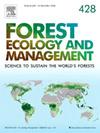利用点云确定单棵树木的竞争压力特征
IF 3.7
2区 农林科学
Q1 FORESTRY
引用次数: 0
摘要
单棵树木的竞争压力可以通过考虑其位置和尺寸(如胸径和相对于邻树的高度)来量化。然而,在野外对这些属性进行测量会限制在特定资源条件下可评估的树木和林分数量。近年来,地面激光扫描(TLS)和机载激光扫描(ALS)数据在描述三维森林结构方面发挥了重要作用。这些数据还可以为评估林分内树木的竞争压力提供高效可靠的工具。因此,我们旨在研究 TLS 和低空 ALS 在表征北方森林中影响单棵树木的竞争压力方面的能力。我们对以下两种方法进行了比较:a)基于对象的方法,即通过识别和描述 TLS 和 ALS 点云中的竞争性邻树来量化竞争;b)基于点云的方法,即考虑代表目标树周围竞争性植被的点云结构的存在。因此,使用 Hegyi 方程计算了三个基于对象的竞争指数 (CI),将树干直径 (CIdbh)、树高 (CIH) 和最大树冠直径 (CIMCD) 作为权重。对于基于点云的方法,树冠密度指数(CDI)和竞争压力指数(CPI)是通过将相对树高设定为 60% 的倒置搜索锥得出的,而竞争压力指数(CICylinder)则是通过计算固定半径圆柱体内竞争植被占据的体素数量得出的。这些基于激光扫描的 CI 与基于原位的 CI 进行了评估,在原位 CI 中,树高和树高被用作 Hegyi 方程中的权重。结果显示,与基于点云的 CIs(r = -0.22-0.37)相比,基于物体的 CIs 与基于原位的 CIs 的相关性更高(r = 0.33-0.48,p 值为 0.001)。与 TLS 和 ALS 相比,基于对象的 CIs 显示出较高的相关性(r = 0.65-0.71,p 值为 0.001),而基于点云的 CIs 则存在较大差异(r = 0.29-0.53,p 值为 0.001)。田间树木的检测率和邻近树木的数量会影响 TLS 和 ALS 数据得出的 CI 与基于原位的 CI 的一致性,尤其是在使用基于对象的 CI 评估竞争压力时。总之,使用 TLS 和 ALS 得出的基于对象的 CI 与基于原位的 CI 相比,能够一致地描述北方管理林中的竞争情况。TLS 是小规模评估的理想选择,而低空 ALS 在评估竞争方面的能力相当类似,但覆盖范围更广。在结构复杂的森林中,可靠的树木检测对于避免低估树木的竞争压力至关重要。本文章由计算机程序翻译,如有差异,请以英文原文为准。
Characterizing the competitive stress of individual trees using point clouds
The competitive stress of individual trees can be quantified by considering their positions and dimensions such as diameter at breast height (dbh) and height with respect to their neighbor trees. However, measurements of these attributes in the field limit the number of trees and stands that can be assessed with given resources. In recent years, terrestrial laser scanning (TLS) and airborne laser scanning (ALS) data have become prominent in characterizing three-dimensional forest structures. These data could also provide efficient and reliable tools to assess the competitive stress of trees within a stand. Therefore, we aimed to investigate the capability of TLS and low-altitude ALS in characterizing the competitive stress affecting individual trees in boreal forests. We compared: a) an object-based approach that quantified competition through the identification and characterization of competing neighbor trees from the TLS and ALS point clouds, and b) a point cloud-based approach where the presence of point cloud structures representing competitive vegetation around a target tree was considered. Accordingly, three object-based competition indices (CIs) utilizing dbh (CIdbh), height (CIH), and maximum crown diameter (CIMCD) as weights were calculated using the Hegyi equation. For the point cloud-based approach, the canopy density index (CDI), and the competitive pressure index (CPI) were derived using an upside-down search cone set at 60 % relative tree height, while the CICylinder was calculated by counting the number of voxels occupied by the competitive vegetation inside a fixed-radius cylinder. These laser scanning-based CIs were assessed against in situ-based CIs where dbh and height were used as weights in the Hegyi equation. The results showed that the object-based CIs were more correlated (r = 0.33–0.48, p-value < 0.001) with the in situ-based CIs in comparison with the point cloud-based CIs (r = −0.22–0.37). The object-based CIs showed a high correlation (r = 0.65–0.71, p-value < 0.001) when compared between TLS and ALS, while a greater variation was observed for the point cloud-based CIs (r = 0.29–0.53, p-value < 0.001). Tree detection rate and the number of neighboring trees in the field affected how well the CIs derived from the TLS and ALS data were in line with the in situ-based CIs, especially when the competitive stress was assessed using the object-based CIs. In conclusion, the object-based CIs derived using TLS and ALS provided consistent characterization of competition in managed boreal forests compared to the in situ-based CIs. While TLS is ideal for small-scale assessments, low-altitude ALS offers a rather similar capacity for assessing competition but with broader coverage. In complex forest structures, reliable tree detection is essential to avoid underestimating the competitive stress of trees.
求助全文
通过发布文献求助,成功后即可免费获取论文全文。
去求助
来源期刊

Forest Ecology and Management
农林科学-林学
CiteScore
7.50
自引率
10.80%
发文量
665
审稿时长
39 days
期刊介绍:
Forest Ecology and Management publishes scientific articles linking forest ecology with forest management, focusing on the application of biological, ecological and social knowledge to the management and conservation of plantations and natural forests. The scope of the journal includes all forest ecosystems of the world.
A peer-review process ensures the quality and international interest of the manuscripts accepted for publication. The journal encourages communication between scientists in disparate fields who share a common interest in ecology and forest management, bridging the gap between research workers and forest managers.
We encourage submission of papers that will have the strongest interest and value to the Journal''s international readership. Some key features of papers with strong interest include:
1. Clear connections between the ecology and management of forests;
2. Novel ideas or approaches to important challenges in forest ecology and management;
3. Studies that address a population of interest beyond the scale of single research sites, Three key points in the design of forest experiments, Forest Ecology and Management 255 (2008) 2022-2023);
4. Review Articles on timely, important topics. Authors are welcome to contact one of the editors to discuss the suitability of a potential review manuscript.
The Journal encourages proposals for special issues examining important areas of forest ecology and management. Potential guest editors should contact any of the Editors to begin discussions about topics, potential papers, and other details.
 求助内容:
求助内容: 应助结果提醒方式:
应助结果提醒方式:


